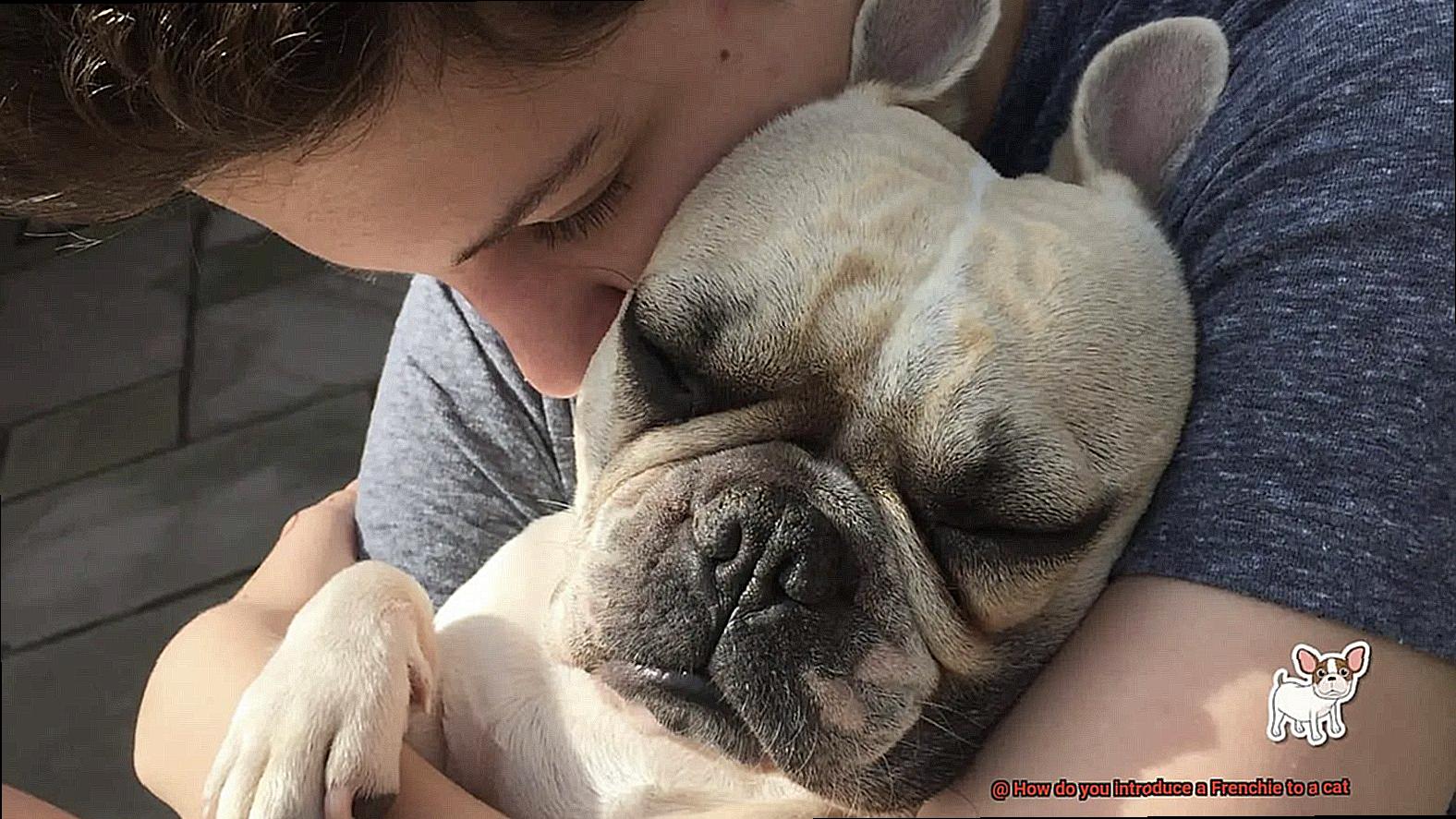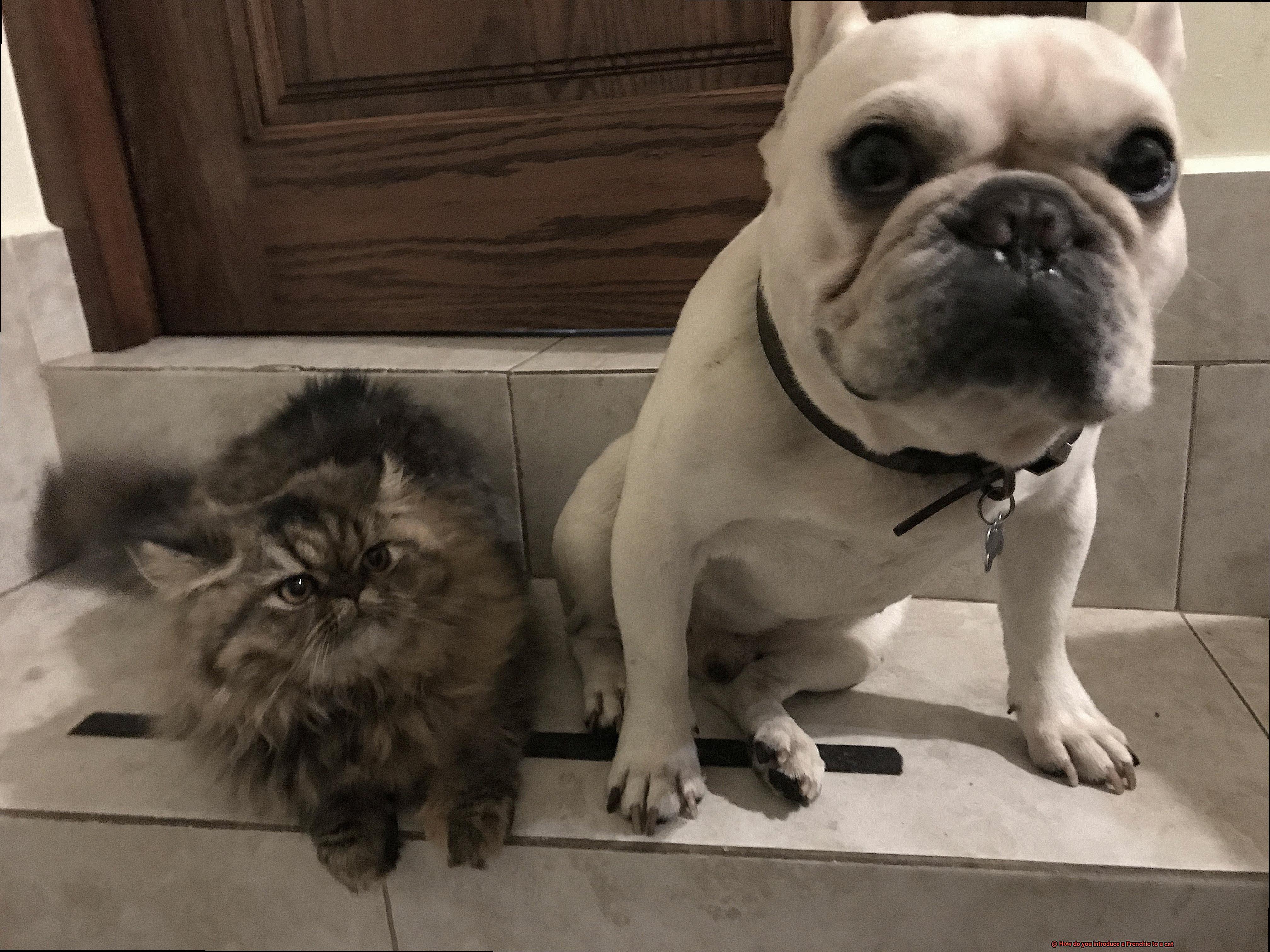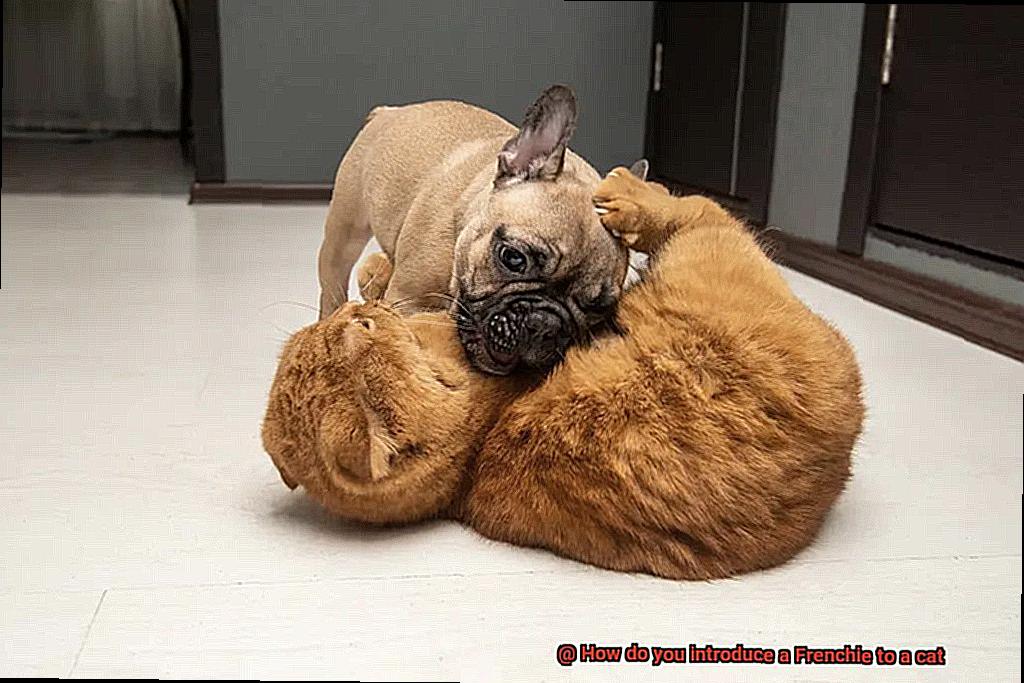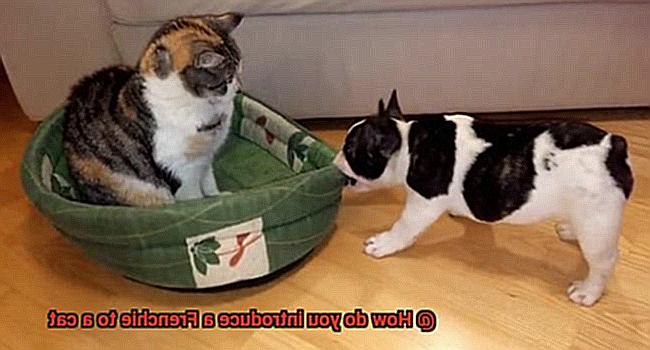How do you introduce a Frenchie to a cat?
Title: Bringing Harmony Home: Introducing Your Frenchie to Your Cat
Introduction:
Contents
- 0.1 Introduction:
- 0.2 Create Safe Spaces:
- 0.3 Sniffing Success:
- 0.4 Take It Slow:
- 0.5 Face-to-Face Time:
- 0.6 Patience Is Key:
- 0.7 Conclusion:
- 1 Preparing a Safe Space for Your Cat
- 2 Familiarizing the Pets with Each Other’s Scent
- 3 Controlled Visual Introductions
- 4 Positive Reinforcement Techniques
- 5 Gradual Physical Introductions
- 6 Supervising and Redirecting Interactions
- 7 Patience and Gradual Progress is Key
- 8 Tips on Dealing with Aggression or Discomfort
- 9 Conclusion
Bringing a new furball into your crib is thrilling, but when it involves introducing a French Bulldog to your resident cat, it can be a tad nerve-wracking. These two come from different worlds, but with a little patience and some know-how, you can create a purrfectly peaceful bond.
As someone who’s been through this myself, I’m stoked to share my insights and tips to make the introduction process smooth sailing. Let’s get started.
Create Safe Spaces:
First things first, set up designated safe zones for both your cat and Frenchie. Give your cat cozy perches and hideouts, while making sure your Frenchie has their own chill spot with a comfy bed or crate.
Sniffing Success:
Cats have noses that rival bloodhounds’, so before any face-to-face meetings, let them get acquainted with each other’s scents. Swap bedding or leave an item of clothing that carries their smell in their respective areas. Familiarity breeds friendship.
Take It Slow:
Start by letting your cat and Frenchie check each other out from a distance. Use baby gates or separate rooms with slightly open doors for visual encounters without direct contact. Gradually increase the duration and frequency of these controlled meetings, keeping an eye on their body language and stress levels. Treats and positive reinforcement go a long way in reinforcing good behavior.
Face-to-Face Time:
Once they’re feeling more comfortable during controlled meetings, it’s time for supervised face-to-face encounters. Keep both pets on leashes or harnesses for added control. Create a relaxed atmosphere with interactive toys or treats as distractions. If things start heating up, be ready to step in quickly and end on a positive note.
Patience Is Key:
Remember, every pet is unique, so the introduction process may vary. Some duos become BFFs instantly, while others take weeks or even months to warm up. Stay patient and let their bond develop naturally. Don’t force interactions and celebrate small victories along the way.
Conclusion:

Introducing a French Bulldog to your cat can be an adventure, but with a little patience and some clever strategies, you can create a harmonious household where tails wag and purrs abound. So, get ready to pave the path to purrfection for your feline and Frenchie duo.
Preparing a Safe Space for Your Cat
Bringing a new pet into your home is an exciting time, but it’s important to ensure a smooth transition for everyone involved. When introducing your cat to a French Bulldog, it’s essential to create a safe and secure space for your feline friend. This guide will walk you through the steps to prepare a safe space for your cat before introducing them to your Frenchie, ensuring a harmonious relationship between the two.

Designated Safe Space:
Create a designated area where your cat can retreat and feel secure. This can be a spare room or a cozy corner of the house. Equip this space with essential items like food and water bowls, litter box, scratching post, and toys. Adding familiar scents, such as a blanket or piece of clothing with your cat’s scent, will help them feel more at ease.
Barrier Between Spaces:

Initially, create a barrier between your cat’s safe space and the rest of the house. Use baby gates or pet gates to prevent the Frenchie from entering this area. This gradual introduction allows your cat to acclimate to their new surroundings without feeling overwhelmed.
Eliminate Hazards:
Ensure that your cat’s safe space is free from any potential hazards or dangers. Remove toxic plants, chemicals, and small objects that could be ingested or pose a risk. Secure electrical cords to prevent cats from playing with them. Close windows and doors to eliminate escape routes.
Calm and Peaceful Atmosphere:
Create a calm and peaceful atmosphere in your cat’s safe space. Soft lighting, soothing music, or pheromone diffusers designed for cats can promote relaxation. Avoid loud noises or sudden disruptions that may startle or stress your cat.
Quality Time Together:
Spend quality time with your cat in their safe space. Engage in interactive play sessions, offer treats, and provide plenty of affection. Building a positive association between your presence and the safe space will enhance your cat’s sense of security.
Conclusion:
Familiarizing the Pets with Each Other’s Scent
Introducing a French Bulldog to a cat can be an exciting but potentially challenging experience. To ensure a smooth transition and minimize any tension or anxiety, it’s essential to familiarize your pets with each other’s scent. By exchanging scents, you can create a sense of familiarity and comfort before their first face-to-face meeting. So, let’s dive into some effective methods for making this happen.
Method 1: Scent Swapping
Scent swapping is a paw-some way to introduce your Frenchie and cat to each other’s scent. Start by taking a cloth or towel and gently rubbing it on one pet, capturing their unique smell. Then, use the same cloth to rub it on the other pet, transferring the scent. Repeat this process several times over a few days, ensuring both animals become accustomed to each other’s smell.
Method 2: Pheromone-based Products
Consider using pheromone-based products designed to calm and relax pets. These products mimic natural pheromones that animals release when they feel content and at ease. By using such products in both the Frenchie and cat’s living areas, you can create a peaceful atmosphere for their introduction.
Method 3: Indirect Exploration
Allowing your pets to explore each other’s living spaces indirectly can also aid in familiarizing them with each other’s scent. For example, let your cat sniff around the Frenchie’s designated area or bed when the dog isn’t present. Similarly, allow the Frenchie to investigate areas where the cat spends time, like scratching posts or perches. This indirect exposure to each other’s scent can gradually build acceptance and curiosity.
Remember:
- Patience is key. Take your time and don’t rush the process.
- Consistency is crucial. Repeat these scent familiarization exercises regularly.
- Each pet needs time to adjust and become comfortable with the new scents.
- Positive reinforcement is essential. Praise and reward both pets for calm behavior during the process.
By taking the time to familiarize your Frenchie and cat with each other’s scent, you’re setting the stage for a successful introduction. This step reduces the chances of conflicts or aggressive behavior during their initial meeting. Remember, it may take days or even weeks for them to fully accept and recognize each other’s scents, so be patient and keep a positive mindset.
Controlled Visual Introductions
Bringing a Frenchie and a cat together can be an exciting and rewarding experience, but it requires careful planning and monitoring. In this blog post, we will delve into the importance of controlled visual introductions and how they can pave the way for a harmonious relationship between your Frenchie and your feline friend.
The Concept of Controlled Visual Introductions
- What are controlled visual introductions?
- Why are they crucial in Frenchie-cat introductions?
- Benefits of controlled visual introductions: reducing aggression and fear.
Creating a Safe Environment
- Separate spaces for the Frenchie and the cat initially.
- Using barriers like baby gates or screen doors.
- Allowing them to see and smell each other without direct contact.


Monitoring Reactions

- Importance of closely observing both animals’ behavior.
- Signs of stress, aggression, or fear to watch out for.
- Taking a step back if negative behaviors are displayed.
Positive Reinforcement
- Using treats or toys as positive reinforcement during introductions.
- Rewarding calm behavior and interest without aggression.
- Creating positive associations with each other’s presence.

Patience and Gradual Progression
- Understanding that each animal has its own unique personality.
- Allowing them to progress at their own pace.
- Repeating controlled visual introductions if needed before physical interactions.
Controlled visual introductions play a vital role in introducing a Frenchie to a cat. By creating a safe environment, closely monitoring reactions, using positive reinforcement, and practicing patience, you can foster a harmonious relationship between your furry friends.
Remember, Rome wasn’t built in a day, and neither is a lasting friendship between a Frenchie and a cat. So take your time, follow these guidelines, and watch their bond blossom over time.

Positive Reinforcement Techniques
Introducing a French Bulldog (Frenchie) to a cat can be a challenging task, but with the right positive reinforcement techniques, you can create a harmonious environment where they can coexist peacefully.
In this blog post, we will explore effective strategies to help your Frenchie and cat get along, using treats, creating separate spaces, gradual scent introductions, supervised interactions, and clicker training.
Treats as Rewards:
- Reward calm and friendly behavior from both the Frenchie and cat with tasty treats.
- Reinforce their good behavior and create positive associations with each other’s presence.
- Use high-value treats to make the rewards more enticing.
Creating Separate Spaces:
- Provide each animal with their own safe space where they can retreat when feeling overwhelmed or anxious.
- This could be a separate room or an area with their own bed, toys, and litter box.
- Giving them control over their environment helps reduce stress and promotes a sense of security.
Gradual Scent Introductions:
- Swap bedding or blankets between the Frenchie and cat to familiarize them with each other’s scent.
- Use interactive toys or treats that contain scents from both animals to create positive associations.
- Slowly introduce their scents without direct contact to build familiarity and comfort.
Supervised Interactions:
- Closely monitor the Frenchie and cat during their initial encounters.
- Address any signs of aggression or discomfort immediately by separating them.
- Gradually increase the duration of their interactions as they become more comfortable with each other.
Clicker Training:
- Use clicker training to associate a distinct sound (the click) with rewards, such as treats.
- Click when both animals display desirable behavior towards each other.
- This helps them associate positive experiences with each other’s presence.
Positive reinforcement techniques, such as using treats, creating separate spaces, gradual scent introductions, supervised interactions, and clicker training, can help foster a positive relationship between your Frenchie and cat. Remember, consistency is key, and patience is the guiding force throughout this gradual process. With time and effort, you can create a pawsitive bond between these two furry friends.
Gradual Physical Introductions
So, you’ve got a French Bulldog and a cat. You love them both dearly, but you’re not quite sure if they’ll be the best of friends. Don’t worry, my friend. I’m here to share with you the secrets of gradual physical introductions that will help these two furballs become the purrfect pals.
Creating a Controlled Environment:
Picture this – a baby gate or pet pen separating your Frenchie and your cat. This allows them to see and sniff each other without any direct paw-to-paw contact. It’s like a meet-and-greet, but with a safety net. This controlled environment ensures that both animals feel secure and reduces the chances of any fur-flying encounters.
Observation Period:
During this observation period, keep an eagle eye on their body language. Look for signs of curiosity, calmness, and non-aggressive behavior. We want tails wagging and whiskers twitching in delight. If either animal shows signs of fear or aggression, it’s time to hit the brakes and seek guidance from the pros.
Short and Sweet Interactions:
Once they’ve had a few days to observe each other from afar, it’s time for some physical interaction. But hold your horses. Keep these initial interactions short and supervised – no marathon sessions just yet. Use a leash and harness for your Frenchie to ensure control (and avoid any “zoomies” around the house.).
Body Language Matters:
As they interact, pay close attention to their body language – it speaks volumes. We’re looking for relaxed postures, playful gestures, and mutual interest. If tension or aggression starts brewing like a stormy sky, separate them immediately. Safety first, my friend.
Unique Personalities:
Remember, every animal is unique, just like you and me. Some Frenchies may be all about chasing or playing, while others might be more reserved. Cats, too, have their own purrsonalities – some may need more time to adjust to the Frenchie’s energy. Respect their individuality and let them set the pace.
Seek Professional Help:
If you’re feeling a bit lost in this furry dance, don’t hesitate to seek guidance from a professional animal behaviorist or trainer. They’ll provide personalized advice based on your specific duo’s dynamics and help you navigate any bumps in the road.
Patience, Consistency, and Positive Reinforcement:
Now, my friend, remember the golden rule of gradual introductions – patience, consistency, and positive reinforcement. Rome wasn’t built in a day, and neither is a beautiful friendship between a Frenchie and a cat. With time and proper guidance, these two can become lifelong companions.
Supervising and Redirecting Interactions
Bringing a French Bulldog and a cat together can be an exciting and rewarding experience. However, it’s important to supervise and redirect their interactions to ensure a harmonious relationship. In this blog post, we’ll explore some essential tips and tricks to help you navigate this delicate dance between your Frenchie and cat.
Start with controlled introductions:
To set the stage for success, begin by creating a controlled environment. Use a baby gate or separate room with a door to establish a physical barrier between your Frenchie and cat. This allows them to gradually get accustomed to each other’s presence without direct contact.
Observe body language:
Just like humans, animals have their own way of communicating through body language. Watch for signs of stress, fear, or aggression such as raised fur, hissing, growling, or barking. If any of these indicators are present, it’s a sign that they may need more time before progressing to direct interactions.
Positive reinforcement is key:
Positive reinforcement is a powerful tool in training both your Frenchie and cat to associate each other’s presence with positive experiences. Reward them with treats, praise, and affection when they exhibit calm and friendly behavior towards each other. This helps build positive associations and fosters trust between them.
Short and supervised interactions:
In the beginning stages, keep the interactions between your Frenchie and cat short and closely supervised. This prevents potential conflicts from escalating and allows you to intervene if necessary. As they become more comfortable with each other, gradually increase the duration of their interactions.
Redirect unwanted behaviors:
If either your Frenchie or cat displays unwanted behaviors during their interactions, it’s important to redirect their attention towards more appropriate activities. For example, if your Frenchie starts chasing or barking at the cat, redirect their focus onto a toy or a training command. Similarly, redirect the cat’s attention towards toys or other engaging activities if it becomes aggressive or fearful.
Provide separate spaces:
To ensure the well-being of both your Frenchie and cat, it’s crucial to give them their own designated spaces within your home. These personal retreats provide a sense of security, allowing them to relax and feel safe away from each other when needed. Be sure to provide separate food, water, litter boxes, and comfortable resting areas in each space.
Patience and Gradual Progress is Key

Introducing a French Bulldog to a cat can be an exciting yet challenging endeavor. Both animals have distinct personalities, and their initial meeting sets the foundation for their future relationship.
To ensure a harmonious coexistence, patience and gradual progress are essential. As an expert in pet behavior and having successfully introduced many French Bulldogs to cats, I want to share my insights and expertise on this topic.
Creating a Safe Environment:
To begin the introduction process, it’s crucial to create separate spaces for the Frenchie and the cat. This allows them to become familiar with each other’s scents without direct contact. Utilize baby gates or pet barriers to provide visual access while maintaining a physical separation for their safety.
Gradual Face-to-Face Introductions:
After the animals are acquainted with each other’s scents, it’s time for face-to-face interactions. However, a barrier should still be present for safety. Using a screen door or transparent pet gate allows them to see each other while preventing any potential conflicts. Start with short sessions and gradually increase the duration over time.
Observing Behavior:
During face-to-face interactions, closely monitor their behavior for signs of stress, fear, or aggression. If any negative behavior is observed, separate them immediately and give them more time to adjust before attempting another introduction. It’s crucial not to force the interaction but let them set their own pace.
Exchanging Scents:
In addition to physical introductions, exchanging bedding or blankets between the Frenchie and the cat helps familiarize them with each other’s scent. This creates a sense of comfort and familiarity, reducing tension or anxiety during future interactions.
Positive Reinforcement:
Positive reinforcement plays a significant role in shaping their behavior towards each other. Reward calm and non-aggressive behavior with treats or praise. This reinforces positive associations and helps build a bond between the Frenchie and the cat.
Patience is Key:
Each animal has its own unique timeline for adjustment and acceptance. Some may take days, weeks, or even months to fully adapt. Remember to be patient and understanding throughout the process. Rushing the introduction can lead to setbacks and potential conflicts.
Tips on Dealing with Aggression or Discomfort
Introducing a Frenchie to a cat can be an exciting but challenging experience. It is important to create a safe and controlled environment to ensure a positive outcome.
In this article, we will explore several tips that will help you introduce your Frenchie to your cat successfully.
Gradual Introduction:
A gradual introduction is essential when bringing a Frenchie and a cat together. Start by keeping them in separate rooms and allow them to become familiar with each other’s scent. This helps reduce initial aggression or discomfort.
Supervision:
When it’s time for face-to-face interaction, closely supervise their interactions. This allows you to address any signs of aggression or discomfort immediately and prevent potential harm to either pet.
Positive Reinforcement:
Using positive reinforcement techniques can help create positive associations between your Frenchie and the cat. Reward them with treats, praise, and rewards for calm and friendly behavior towards each other. This encourages a harmonious relationship over time.
Separate Safe Spaces:
Provide separate safe spaces for both the Frenchie and the cat. Each pet should have their own designated area where they can retreat if they feel overwhelmed or need some alone time. Equip these spaces with comfortable bedding, toys, and food/water bowls.
Distraction Techniques:
If either pet displays signs of aggression or discomfort, distraction techniques can be helpful in redirecting their focus. Use toys, playtime, or treats to divert their attention from potential conflicts.
Professional Help:
In some cases, introducing a Frenchie to a cat may require professional assistance if there are persistent aggression or extreme discomfort issues. A professional dog trainer or animal behaviorist can provide expert guidance and help facilitate the introduction process.
sdmlww2zzVc” >
Conclusion
Introducing a Frenchie to a cat can be a delicate process, but with patience and proper guidance, it can lead to a harmonious coexistence between these two furry friends.
The key is to take things slow and allow them to become familiar with each other’s scents before any face-to-face interactions. Gradually introduce them in controlled environments, ensuring both animals feel safe and secure.
Remember, every cat and Frenchie is unique, so be prepared for some trial and error along the way.




